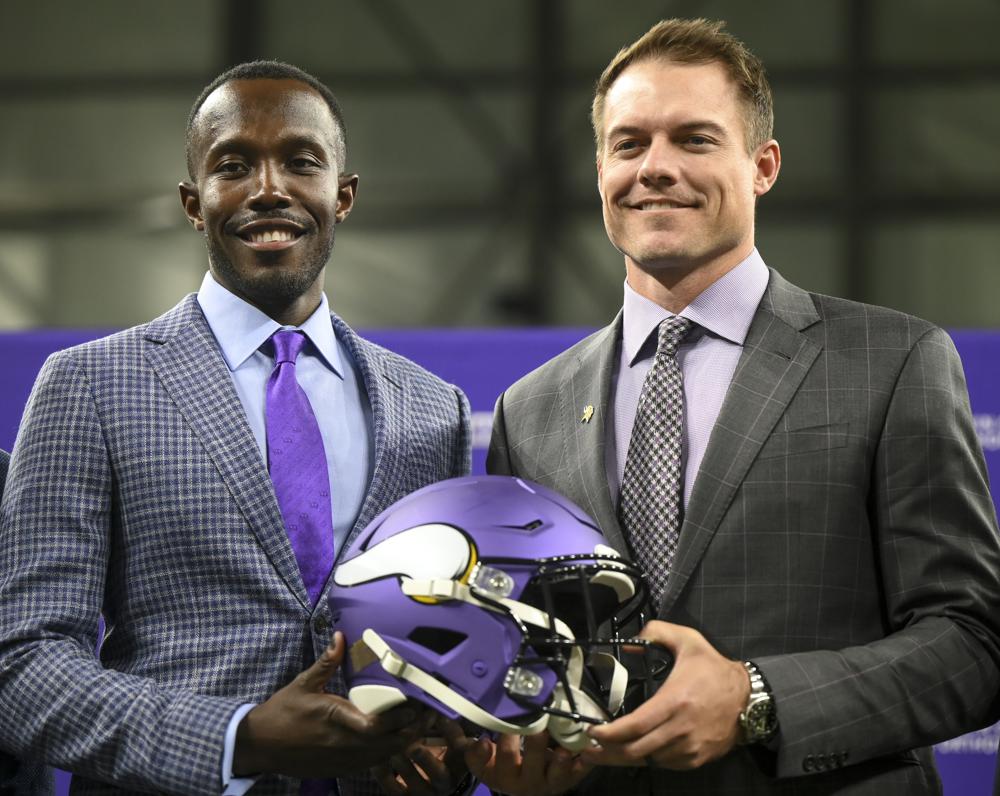
MINNEAPOLIS (AP) — New Minnesota Vikings general manager Kwesi Adofo-Mensah worked eight years on Wall Street, in between economics degrees from Princeton and Stanford.
Yet he still found himself chasing a challenge, into the controlled-market financial arena of pro football roster building.
The first offseason for Adofo-Mensah with the Vikings will be a tall task. They’re facing a $45 million salary cap charge on the final year of quarterback Kirk Cousins’ existing contract, and their current commitments project to be more than $15 million over the cap.
“There’s a little bit of art, and there’s a little bit of science. That’s what makes the puzzle fun,” Adofo-Mensah said. “Honestly, that’s what drew me to this sport, and it’s why I think all of us love competing at the highest level.”
The salary cap for 2022 is projected at $208.2 million per team, a $25.7 million spike from last year. The pandemic-related revenue drop during the empty-stadium season of 2020 triggered an unprecedented $15.7 million decrease for 2021. Contracts negotiated prior to COVID-19′s descendance on the league were also calculated with the customary rise in mind.
While the overall landscape looks smoother this year than last year, success in the fall and winter will require creative and courageous decisions in the spring. Bigger cap increases are coming once the new media rights deals kick in for 2023, but that windfall won’t help the Vikings now.
The same goes for the New Orleans Saints, Green Bay Packers, Dallas Cowboys and Super Bowl champion Los Angeles Rams, the four other teams whose cap situations are the furthest in the red with less than two weeks before free agency begins.
According to figures compiled by Over the Cap, an NFL salary tracking website, as of Thursday the Saints are approximately $42 million over the threshold, followed by the Packers ($31 million), Cowboys ($22 million), Rams ($21 million) and Vikings. Not only do teams need to get under the cap for compliance, they must save space for draft picks, and that’s before signing any new players on the market.
Those five NFC teams went a combined 54-31 last season, and the Packers, Cowboys and Rams accounted for three of the NFL’s six best records. There’s usually a price for contending — and in the case of the Rams, winning it all — that comes in subsequent years in the form of cap challenges.
“The pandemic certainly threw a wrench into everything as far as the salary cap numbers and they’d be so steady for so long,” Packers general manager Brian Gutekunst said. “You kind of had that comforting feeling of where it’s going to be. When that got changed, with where our team was at, it made it a little more difficult. We’re very hopeful we’re coming out of that.”
The Packers are waiting for word from four-time MVP Aaron Rodgers, whose cap hit of more than $46 million for 2022 would almost certainly be lowered with a contract extension if he returns. All-Pro wide receiver Davante Adams can become a free agent, so they’d have to fit him in, too.
That means restructuring more veteran deals, as they’ve already done with defensive tackle Kenny Clark, or flat out releasing accomplished players. Outside linebacker Za’Darius Smith could well be one of those, with cap relief of more than $15 million if released.
The Cowboys are now dealing with the welcomed-but-daunting ramifications of having a franchise quarterback, Dak Prescott, on his second contract. They could create $16 million in cap space by cutting wide receiver Amari Cooper and another $8 million by dumping defensive end DeMarcus Lawrence. The problem is those are two vital players.
“We can have another good roster again, but we’re going to have to massage this and we’re not going to be able to keep everybody, and we’re going to have to be efficient in free agency and we’re going to have to be efficient in the draft,” Cowboys executive Stephen Jones said.
Speaking to reporters at the combine in Indianapolis, Jones aptly summed up the annual conundrum for just about every team in the league.
“We could do some things that could allow us to keep most of our guys if we wanted to push it all out, but we’ll have a much bigger problem the next year and the year after that,” he said.
The Rams are a shining example of the benefit of the all-in approach favoring now over then, not to mention the separate issue of trading future draft picks for star players.
Contract restructures for perhaps six of their highest-paid veterans, among them quarterback Matthew Stafford, defensive tackle Aaron Donald and cornerback Jalen Ramsey, are expected this month. Rams general manager Les Snead and his lieutenants have deftly maneuvered through these obstacle courses before, leaving no doubt they can do so again and keep the Rams largely intact for a run at a repeat.
While cap trouble can be a real consequence of short-sighted strategy, rarely it is a deal breaker for a front office. There are always different ways to arrange the salaries and bonuses to fit the best players under the cap. The fans and the media are typically the groups sounding the alarms.
That’s why it’s possible for a team like the Vikings, coming off an 8-9 finish, to keep a market-rate quarterback in Cousins for at least another season and also upgrade some positions around him.
“We’ve got our leadership here in place that we are built to be successful right away. We feel very confident about that,” owner and president Mark Wilf said. “We’re going to work with Kirk as our quarterback and we’ll move forward from there, but for 2022, for sure, we’re going to be super competitive. Sustained success is the goal, and I think we have it with this leadership.”
